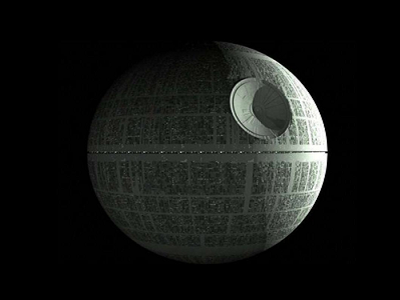White House Web Petition Urges Construction of Death Star
Besides rather depressing topics such as the fiscal cliff, there is good reason for the U.S. government to focus on more upbeat tasks to keep us motivated. Such as the construction of a Death Star.
There is, in fact, an online petition on the White House website that suggests such a project, supported by common sense conclusions that serve the purposes of employment, science and national security. From the post:
"By focusing our defense resources into a space-superiority platform and weapon system such as a Death Star, the government can spur job creation in the fields of construction, engineering, space exploration, and more, and strengthen our national defense."
At the time of this writing, the petition needed about 20,600 more signatures. Of course, building an actual Death Star would be a massive project that would cost roughly $852 quadrillion to construct a spaceship that is about 90 miles in diameter and would need 1 quadrillion tons of steel to be completed.
That may sound extreme, but if you consider the fact that Earth has enough iron supply to come up with the material for 2 billion Death Stars and that it would take 833,315 years to produce enough steel to start work on a Death Star, it would require us to spend only $1 trillion per year to plan the construction. Consider the lucky circumstance that the U.S. currently has debt of more than $16 trillion and there is a good chance that an additional $1 trillion per year could be squeezed into this debt without anyone noticing.
Of course, that scenario would be based on the assumption that we can wait 833,000 years, before we are attacked by an intelligent life form in the Universe. Voyager 1 and 2, which were launched in 1977 are on their way into interstellar space, more than 10 billion miles away from Earth are believed to be within 1.6 light years (or 9.3 trillion miles) of AC+79 3888, a star in the constellation of Camelopardalis, in about 40,000 years, NASA said. In 296,000 years, Voyager 2 will be within 4.3 light years (25 trillion miles) from Sirius, providing space population with a clear map how to find Earth.
Contact Us for News Tips, Corrections and Feedback
Get Tom's Hardware's best news and in-depth reviews, straight to your inbox.

Wolfgang Gruener is an experienced professional in digital strategy and content, specializing in web strategy, content architecture, user experience, and applying AI in content operations within the insurtech industry. His previous roles include Director, Digital Strategy and Content Experience at American Eagle, Managing Editor at TG Daily, and contributing to publications like Tom's Guide and Tom's Hardware.
-
NightLight 2 things: don't make the exhaust port reachable by a snub fighter, and don't make a path right to the core, this might cause giant explosions....Reply -
Polluted NightLight2 things: don't make the exhaust port reachable by a snub fighter, and don't make a path right to the core, this might cause giant explosions....Reply
Pffft, as long as the port is only two meters wide it'll be fine. -
jacobdrj PollutedPffft, as long as the port is only two meters wide it'll be fine.Yeah, and just Ray Shield it... That way, nothing short of proton torpedoes could breach it anyways, even if a snub fighter did manage to fire it into that 2 meter hole...Reply -
internetlad PollutedPffft, as long as the port is only two meters wide it'll be fine.Reply
You'd need some advanced electronics designed to hit tiny targets, or something. bahaha.
-
internetlad PollutedPffft, as long as the port is only two meters wide it'll be fine.Reply
Doubt anybody could hit a target the size of a womp rat with a fighter LOL
-
A Bad Day Why build one super death planet that can't respond to multiple attacks (if we ever colonize other solar systems), when we can use the resources in much smaller and larger number of units. Not to mention it would also encourage the enemy to invest in one giant anti-Deathstart instead of countering massed harassment attacks.Reply
There's a reason why Germany never built their 1500 ton super tank back during WWII. Too immobile, and too big of a target for bombers and artillery. -
internetlad Obama: "What they heck is this petition for? To build a new Moon?"Reply
Aide: "That's no Moon. . ."
